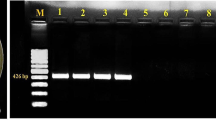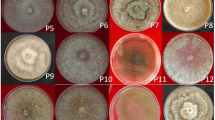Abstract
The oomycetous fungus Phytophthora colocasiae that causes taro leaf blight is one of the most devastating diseases of taro and is widely distributed in India. A combination of morphological (colony morphology, mating type, pathogenicity, metalaxyl sensitivity) and molecular techniques (rDNA ITS sequencing and Start codon targeted polymorphism, ScoT analysis) was used to characterize 50 isolates of P. colocasiae obtained from different locations in India. Considerable differences in morphological parameters were observed. ScoT analysis revealed high polymorphism among the isolates. This study confirms that isolates of P. colocasiae are highly dynamic in nature and a considerable degree of diversity exists among them. A detailed knowledge of the morphological and molecular characters of P. colocasiae will help in developing suitable control strategies against the taro leaf blight disease.





Similar content being viewed by others
References
Baskarathevan, J., Jaspers, M. V., Jones, E. E., Cruickshank, R. H., & Ridgway, H. J. (2012). Genetic and pathogenic diversity of Neofusicoccum parvum in New Zealand vineyards. Fungal Biology, 116, 276–288.
Butler, E. J., & Kulkarni, G. S. (1913). Colocasia blight caused by Phytophthora colocasiae Rac. Memoirs of the Department of Agriculture in India, 5, 233–259.
Collard, B. C. Y., & Mackill, D. J. (2009). Start Codon Targeted (SCOT) polymorphism: A simple novel DNA marker technique for generating gene-targeted markers in plants. Plant Molecular Biology, 27, 86–93.
Cooke, D. E. L., & Duncan, J. M. (1997). Phylogenetic analysis of Phytophthora species based on ITS1 and ITS2 sequences of the ribosomal RNA gene repeat. Mycological Research, 101, 667–677.
Costamilan, L. M., Clebsch, C. C., Soares, R. M., Seixas, C. D. S., Godoy, C. V., & Dorrance, A. E. (2012). Pathogenic diversity of Phytophthora sojae pathotypes from Brazil. European Journal Plant Pathology. doi:10.1007/s10658-012-0128-9.
Excoffier, L., Smouse, P. E., & Quattro, J. M. (1992). Analysis of molecular variance inferred from metric distances among DNA haplotypes: application to human mitochondrial DNA restriction data. Genetics, 131, 479–491.
Gisi, U., & Cohen, Y. (1996). Resistance to phenylamide fungicides: case study with Phytophthora infestans involving mating type and race structure. Annual Review of Phytopathology, 34, 549–572.
Goodwin, S. B. (1997). The population genetics of Phytophthora. Phytopathology, 97, 462–473.
Goodwin, S. B., Sujkowski, L. S., & Fry, W. E. (1995). Rapid evolution of pathogenicity within clonal lineages of the potato late blight disease fungus. Phytopathology, 85, 669–667.
Granke, L. L., Quesada-Ocampo, L. M., & Hausbeck, M. K. (2011). Variation in phenotypic characteristics of Phytophthora capsici isolates from a worldwide collection. Plant Disease, 95, 1080–1088.
Institute, S. A. S. (2008). SAS/STAT 9.2 User’s Guide. Cary, NC, USA: SAS Institute.
Jackson, G. V. H., Gollifer, D. E., & Newhook, F. J. (1980). Studies on the taro leaf blight fungus Phytophthora colocasiae in the Solomon Islands: control by fungicides and spacing. Annals of Applied Biology, 96, 1–10.
Ko, W. H. (1979). Mating type distribution of Phytophthora colocasiae in the island of Hawaii. Mycologia, 71, 434–437.
Lambert, D. H., & Salas, B. (1994). Metalaxyl insensitivity of Phytophthora erythroseptica isolates causing pink rot of potato in Maine. Plant Disease, 78, 1010.
Lebot, V., Herail, C., Gunua, T., Pardales, J., Prana, M., Thongjiem, M., et al. (2003). Isozyme and RAPD variation among Phytophthora colocasiae isolates from South East Asia and the Pacific. Plant Pathology, 52, 303–313.
Mahto, N. B., Gurung, S., Nepal, A., & Adhikari, T. B. (2012). Morphological, pathological and genetic variations among isolates of Cochliobolus sativus from Nepal. European Journal of Plant Pathology, 133, 405–417.
Mantel, N. (1967). The detection of disease clustering and generalized regression approach. Cancer Research, 27, 209–220.
McDonald, B. A., & Linde, C. C. (2002). Pathogen population genetics, evolutionary potential and durable resistance. Annual Review of Phytopathology, 40, 349–379.
Mishra, A. K., Sharma, K., & Misra, R. S. (2010). Isozyme and PCR-based genotyping of epidemic Phytophthora colocasiae associated with taro leaf blight. Archives of Phytopathology and Plant Protection, 43, 1367–1380.
Misra, R. S., & Chowdhury, S. R. (1997). Phytophthora leaf blight disease in taro. Technical Bulletin Series 21, C.T.C.R.I. (ICAR), Trivandrum, India.
Misra, R. S., Mishra, A. K., Sharma, K., Jeeva, M. L., & Hegde, V. (2011). Characterisation of Phytophthora colocasiae isolates associated with leaf blight of taro in India. Archives of Phytopathology and Plant Protection, 44, 581–591.
Misra, R. S., Sharma, K., & Mishra, A. K. (2008). Phytophthora leaf blight of taro (Colocasia esculenta) – a review. The Asian and Australasian Journal of Plant Science and Biotechnology, 2, 55–63.
Nath, V. S., Sankar, M. S., Hegde, V. M., Jeeva, M. L., Misra, R. S., & Veena, S. S. (2013a). Molecular evidence supports hypervariability in Phytophthora colocasiae associated with leaf blight of taro. European Journal of Plant Pathology, 136, 483–494.
Nath, V. S., Sankar, M. S., Hegde, V. M., Jeeva, M. L., Misra, R. S., Veena, S. S., et al. (2013b). Genetic diversity of Phytophthora colocasiae isolates in India based on AFLP analysis. 3 Biotech, 3, 297-305.
Nei, M., & Li, W. H. (1979). Mathematical model for studying genetic variation in terms of restriction endonucleases. Proceedings of the National Academy of Sciences of the USA, 76, 5269–5273.
Parra, G., & Ristaino, J. B. (2001). Resistance to mefenoxam and metalaxyl among field isolates of Phytophthora capsici causing Phytophthora blight of bell pepper. Plant Disease, 85, 1069–1075.
Raciborski, M. (1900).Parasitische Algen und Pilze, Java’s (Java’s Parasitic Algae and Fungi). I. Batavia. (Cited in Waterhouse1970a under P. colocasiae).
Rampersad, S. N. (2011). Molecular and phenotypic characterization of Colletotrichum species associated with anthracnose disease of papaya in Trinidad. Plant Disease, 95, 1244–1254.
Reuveni, M., Eyal, H., & Cohen, Y. (1980). Development of resistance to metalaxyl in Pseudoperonospora cubensis. Plant Disease, 64, 1108–1109.
Rohlf, F. J. (1993). Contributions to morphometrics: Relative warp analysis and an example of its application to mosquito wings. pp. 131–159. In L. F. Marcus, E. Bello, and A. García-Valdecasas (Eds.) Monografias del Museo Nacional de Ciencias Naturales. Madrid, Spain.
Saitou, N., & Nei, M. (1987). The neighbor-joining method: A new method for reconstructing phylogenetic trees. Molecular Biology and Evolution, 4, 406–425.
Schluter, P. M., & Harris, S. A. (2006). Analysis of multilocus fingerprinting data sets containing missing data. Molecular Ecology Notes, 6, 569–572.
Silvar, C., Merino, F., & Diaz, J. (2006). Diversity of Phytophthora capsici in Northwest Spain: analysis of virulence, metalaxyl response, and molecular characterization. Plant Disease, 90, 1135–1142.
Tamura, K., Peterson, D., Peterson, N., Stecher, G., Nei, M., & Kumar, S. (2011). MEGA5: molecular evolutionary genetics analysis using maximum likelihood, evolutionary distance, and maximum parsimony methods. Molecular Biology and Evolution, 28, 2731–2739.
Thompson, J. D., Higgins, D. G., & Gibson, T. J. (1994). Clustal-W—improving the sensitivity of progressive multiple sequence alignment through sequence weighting, position-specific gap penalties and weight matrix choice. Nucleic Acids Research, 22, 4673–4680.
Truong, N. V., Liew, E. C. Y., & Burgess, L. W. (2010). Characterisation of Phytophthora capsici isolates from black pepper in Vietnam. Fungal Biology, 114, 160–170.
Tyson, J. L., & Fullerton, R. A. (2007). Mating types of Phytophthora colocasiae from the Pacific region, India and South-east Asia. Australasian Plant Disease Notes, 2, 111–112.
Van de Peer, Y., & Dewachter, R. (1994). Treecon for Windows—A software package for the construction and drawing of evolutionary trees for the Microsoft Windows environment. Computer Applications in the Biosciences, 10, 569–570.
Van Hemelrijck, W., Debode, J., Heungens, K., Maes, M., & Creemers, P. (2010). Phenotypic and genetic characterization of Colletotrichum isolates from Belgian strawberry fields. Plant Pathology, 59, 853–861.
White, T. J., Bruns, T., Lee, S., & Taylor, J. (1990). Amplification and direct sequencing of fungal ribosomal RNA genes for phylogenetics. pp. 315–322. In M. A. Innes, D. H. Gefland, J. Sninsky, & T. J. White (Eds.), PCR protocols: a guide to methods and applications. SanDiego, CA, USA: Academic.
Yeh, F. C., Boyle, T., Yang, R., Ye, Z., & Xiyan, J. M. (1997). Microsoft window-based freeware for population genetic analysis (POPGENE version 1.31). Edmonton, Canada: University of Alberta and Centre for International Forestry Research.
Acknowledgments
The funding provided for conducting the research work by the Indian Council of Agricultural Research, New Delhi, under IISR outreach program, is gratefully acknowledged. The authors thank the reviewer’s for their valuable comments.
Author information
Authors and Affiliations
Corresponding author
Rights and permissions
About this article
Cite this article
Nath, V.S., Hegde, V.M., Jeeva, M.L. et al. Morphological, pathological and molecular characterization of Phytophthora colocasiae responsible for taro leaf blight disease in India. Phytoparasitica 43, 21–35 (2015). https://doi.org/10.1007/s12600-014-0422-5
Received:
Accepted:
Published:
Issue Date:
DOI: https://doi.org/10.1007/s12600-014-0422-5




